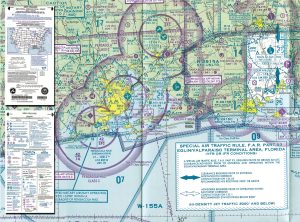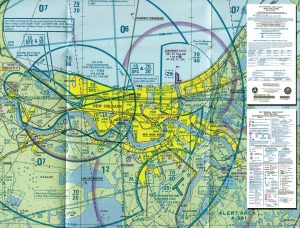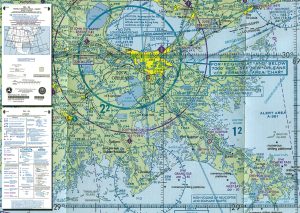This introduction to aeronautical charts comes from the Pilot’s Handbook of Aeronautical Knowledge, a foundational text for any student pilot.
An aeronautical chart is the road map for a pilot flying under VFR. The chart provides information which allows pilots to track their position and provides available information which enhances safety. The three aeronautical charts used by VFR pilots are sectional charts, VFR terminal area charts, and world aeronautical charts.
Sectional Charts
Sectional charts are the most common charts used by pilots today. The charts have a scale of 1:500,000 (1 inch = 6.86 nautical miles (NM) or approximately 8 statute miles (SM)) which allows for more detailed information to be included on the chart.
The charts provide an abundance of information, including airport data, navigational aids, airspace, and topography. The figure below is an excerpt from the legend of a sectional chart. By referring to the chart legend, a pilot can interpret most of the information on the chart. A pilot should also check the chart for other legend information, which includes air traffic control (ATC) frequencies and information on airspace. These charts are revised semiannually except for some areas outside the conterminous United States where they are revised annually.
VFR Terminal Area Charts
VFR terminal area charts are helpful when flying in or near Class B airspace. They have a scale of 1:250,000 (1 inch = 3.43 NM or approximately 4 SM). These charts provide a more detailed display of topographical information and are revised semiannually, except for several Alaskan and Caribbean charts.
World Aeronautical Charts
World aeronautical charts are designed to provide a standard series of aeronautical charts, covering land areas of the world, at a size and scale convenient for navigation by moderate speed aircraft. They are produced at a scale of 1:1,000,000 (1 inch = 13.7 NM or approximately 16 SM). These charts are similar to sectional charts and the symbols are the same except there is less detail due to the smaller scale. These charts are revised annually except for several Alaskan charts and the Mexican/Caribbean charts which are revised every two years.
A detailed introduction to using aeronautical charts, as well as how they are used in conjunction with navigation can be found in the Pilot’s Handbook of Aeronautical Knowledge, available from ASA.







